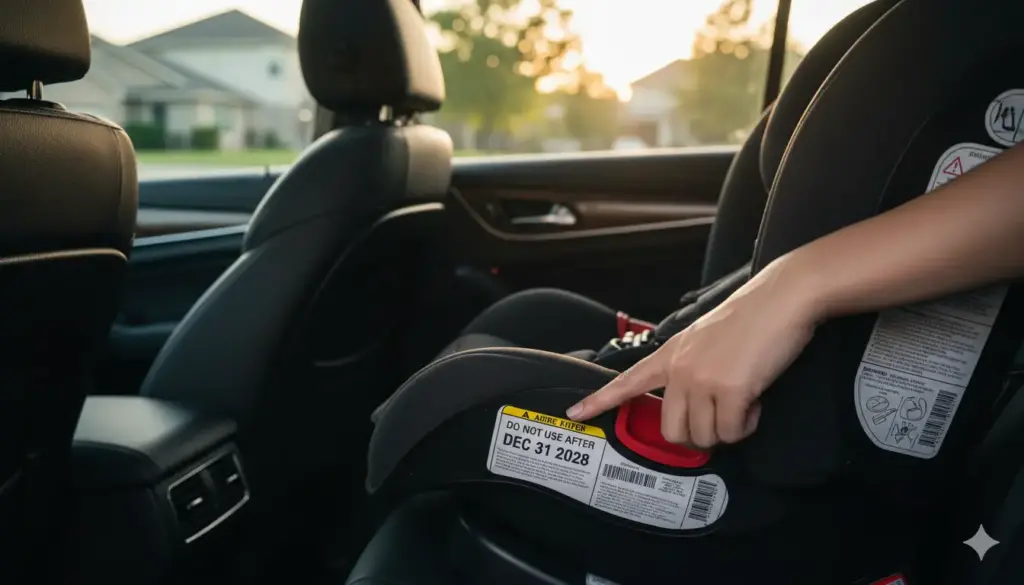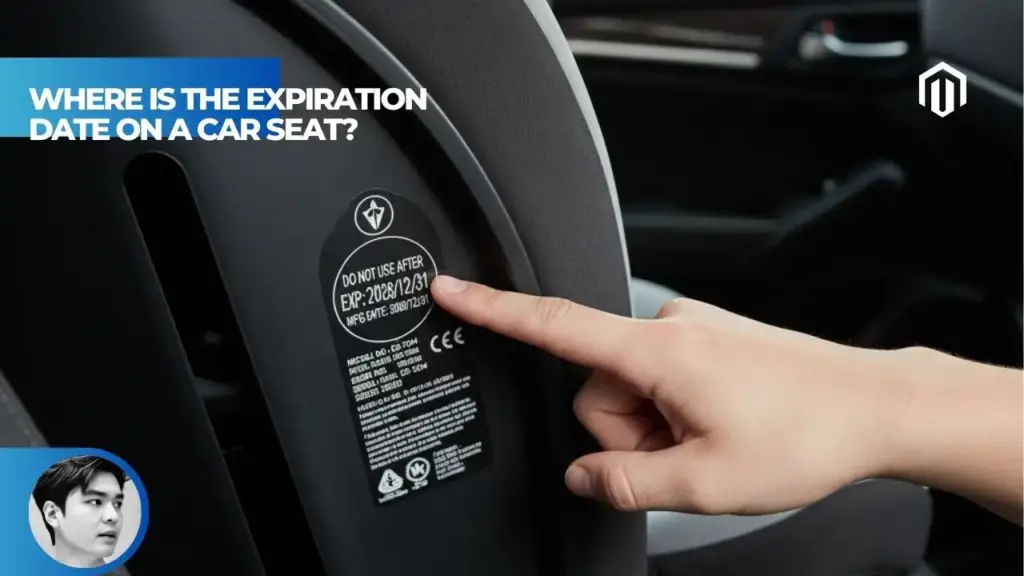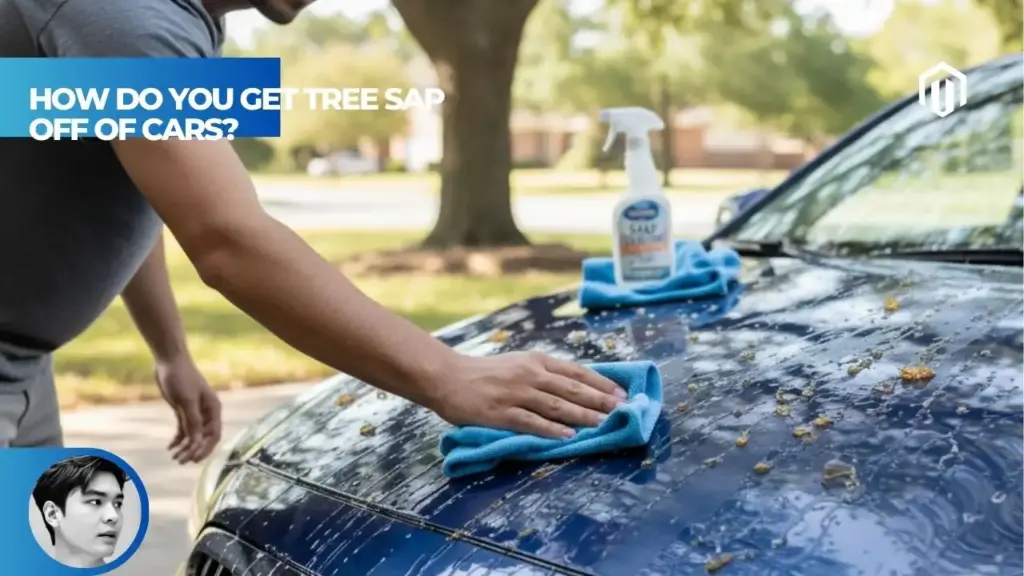You may also like:
- 【Explained】When Does the 2-Hour Car Seat Rule End for Babies?
- 【Explained】How to Put Infant Car Seat on Shopping Cart? Safety First
- 【Explained】When to Take Newborn Insert Out of Car Seat? (The Manufacturer’s Manual is Key)
- 【Review】Top 7 Best Ways to Clean a Car After a Body Repair
- 【Explained】What Happens When Your Car Is Totaled But Still Drivable?
The expiration date on a car seat is most commonly found on a sticker on the back or bottom of the seat, or molded directly into the plastic shell, typically showing either the expiration date or the date of manufacture (DOM) from which you calculate expiration. For infant car seats, check both the carrier and the base separately, as both components have the same expiration date but may display the information in different locations.

Car Seat Expiration Date Location – Where to Look
Finding your car seat’s expiration date is crucial for ensuring your child’s safety. According to the National Highway Traffic Safety Administration (NHTSA), manufacturers use expiration dates to indicate the expected useful life of their products[1].
Car seat expiration dates aren’t arbitrary numbers. They represent the manufacturer’s confidence in the product’s structural integrity and safety performance over time. Autvex safety experts emphasize that using an expired car seat is like ignoring warning indicators in your vehicle—both compromise safety.
How to Find Car Seat Expiration on the Shell
The most common location for expiration dates is on a white or gray sticker attached to the plastic shell[2]. Turn your car seat around and check the back, bottom, or sides for manufacturer labels.
Look for these specific areas:
- Back of the seat shell near the top
- Bottom of the seat base
- Side wings where the harness threads through
- Along the edges of the seat shell
- Under removable seat padding
The sticker typically contains multiple pieces of information including the model number, serial number, date of manufacture, and either the expiration date or the seat’s lifespan in years.
Car Seat Serial Number and DOM (Date of Manufacture) Location
The serial number and DOM are essential for determining expiration when it’s not explicitly printed[3]. These identifiers also help with recall checks and warranty claims.
| Information Type | Common Location | Format Example |
|---|---|---|
| Serial Number | Bottom of seat | SN: 123456789 |
| Date of Manufacture | Back sticker | DOM: 03/15/2020 |
| Model Number | Side label | Model: 1234567 |
| Expiration | Bottom/back | EXP: 03/15/2027 |
If only the DOM is visible, add the manufacturer’s stated lifespan (typically 6-10 years) to calculate the expiration date.
Checking Car Seat Owner’s Manual for Expiration Information
Your car seat’s manual contains critical expiration information when the physical seat doesn’t clearly display it. Keep the manual stored with your important documents as it’s your primary reference for safety information[3].
The manual typically includes:
- Specific lifespan for your model
- How to calculate expiration from DOM
- Where to find dates on your specific seat
- Contact information for manufacturer questions
Many manufacturers now offer digital manuals online, searchable by model number. This proves helpful when buying used items that may lack original documentation.
Understanding Car Seat Shell Expiration Date Markings
Manufacturers use various methods to display expiration information, and understanding these different formats helps ensure accurate interpretation of safety dates.
Reading the Date of Manufacture Sticker
Date of manufacture stickers follow standard formats but vary by brand[2]. Understanding these formats prevents misinterpretation of critical safety information.
Common date formats include:
- MM/DD/YYYY (03/15/2020)
- DD/MM/YYYY (15/03/2020)
- Month spelled out (March 15, 2020)
- Julian date (075/20 for the 75th day of 2020)
- Week/Year format (12/20 for 12th week of 2020)
Some manufacturers use codes requiring the manual for interpretation. When uncertain, contact the manufacturer directly with your serial number for clarification.
Calculating Expiration from DOM When Not Printed
When only the DOM appears, you must know the manufacturer’s specified lifespan to determine expiration[4]. This calculation becomes your responsibility as the caregiver.
Standard lifespans by seat type:
- Infant carriers: 6-7 years
- Convertible seats: 7-10 years
- All-in-one seats: 10 years
- Booster seats: 6-10 years
- Seat bases: Same as carrier
For example, a seat manufactured on 03/15/2020 with a 7-year lifespan expires on 03/15/2027. Mark this date in your calendar immediately.
Where Is the Expiration Date on a Graco Car Seat Specifically
Graco places expiration information on the bottom or back of their seats, requiring calculation from the DOM[4]. Graco doesn’t print explicit expiration dates but provides clear lifespan guidelines.
Graco expiration periods:
- 7 years: Plastic-reinforced belt path models (Contender, Extend2Fit)
- 10 years: Steel-reinforced belt path models and boosters
To find your Graco seat’s information:
- Turn seat upside down or check the back
- Locate white label with DOM
- Note if your model has plastic or steel reinforcement
- Add 7 or 10 years accordingly
Autvex recommends photographing these labels immediately after purchase for easy reference, similar to documenting vehicle specifications.
Do Car Seat Bases Expire Too?
Parents often overlook that car seat bases have their own expiration considerations, particularly important for families using multiple bases or sharing between vehicles.
Infant Car Seat Base Expiration Locations
Car seat bases expire on the same date as their corresponding carrier[5]. The expiration information typically appears on the base’s underside or along the belt path area.
Check these specific base locations:
- Bottom of base (flip it over)
- Along the belt path where seat belt threads
- Side of base near level indicators
- Under rubber grip pads
- On adjustment mechanisms
Many parents purchase extra bases for multiple vehicles. Each base should be checked individually, as manufacture dates may differ even within the same purchase.
Comparing Carrier vs Base Expiration Dates
The carrier and base share the same expiration date when sold as a system[5]. However, separately purchased bases may have different manufacture dates.
Important considerations:
- Travel systems (stroller + car seat) follow car seat expiration
- Replacement bases must not exceed original expiration
- Used bases require independent verification
- Some bases work with multiple carrier models
- Always use the earliest expiration date when mixing components
Document both dates when using separate pieces, especially if acquired at different times or from different sources.
Checking Both Components for Safety
Inspect both the carrier and base during every installation to ensure neither has exceeded its useful life[1]. This dual-check system prevents overlooking critical expiration dates.
Safety check protocol:
- Verify carrier expiration before each transition (infant/convertible/booster)
- Check base when moving between vehicles
- Inspect after any incident or rough handling
- Review dates during spring/fall time changes
- Confirm compatibility when borrowing or buying used
This vigilance mirrors the attention needed when inspecting vehicles for safety compliance.

Why Do Car Seats Expire – Safety Considerations
Understanding the science behind expiration dates helps parents appreciate their importance beyond mere manufacturer recommendations. These dates reflect genuine safety concerns backed by extensive testing.
Material Degradation Over Car Seat Lifespan
Plastic and fabric components deteriorate over time through molecular breakdown[6]. This degradation isn’t always visible but significantly impacts crash performance.
Degradation factors include:
- UV exposure: Breaks down plastic polymers
- Temperature cycles: Causes expansion/contraction stress
- Humidity: Weakens adhesives and fabrics
- Mechanical stress: Repeated buckling creates fatigue
- Chemical exposure: Cleaning products accelerate breakdown
Cars experience temperature swings from -20°F to 140°F throughout the year. These extremes accelerate material aging beyond what indoor products experience.
Car Seat Safety Standards Evolution
NHTSA updates safety standards regularly, with major changes coming in 2025-2026[1]. New regulations require enhanced side-impact protection that older seats cannot meet.
Recent safety improvements include:
- Side-impact testing requirements (effective December 2026)
- Enhanced head protection standards
- Improved harness strength requirements
- Better labeling for proper use
- Advanced energy absorption materials
Using an expired seat means missing these critical safety advances. It’s similar to how modern vehicles offer superior protection compared to older models.
Unknown History and Crash Involvement Risks
Car seats are single-use safety devices after crashes, even minor ones[6]. Expiration dates help prevent circulation of potentially compromised seats.
Hidden damage risks:
- Stress fractures invisible to naked eye
- Compromised load-bearing points
- Weakened harness attachment points
- Damaged energy-absorbing foam
- Loosened structural connections
Without knowing a seat’s complete history, expiration dates provide a definitive cutoff for safe use, protecting children from seats with unknown damage.
Used Car Seat Safety and Expiration Verification
The secondhand market presents unique challenges for car seat safety. While budget-conscious parents may consider used options, proper verification becomes critical.
Is It Safe to Use a Secondhand Car Seat?
Used car seats are only safe when you know their complete history[7]. NHTSA recommends extreme caution with secondhand seats due to unknown factors.
Essential verification checklist:
- ✓ Confirm expiration date hasn’t passed
- ✓ Verify no crash involvement
- ✓ Check for all parts and manual
- ✓ Research recall status
- ✓ Inspect for visible damage
- ✓ Confirm proper model for child’s size
Many experts recommend buying new when possible, as the cost difference is minimal compared to potential risks. Consider this like choosing [safety equipment]—reliability matters most.
What Happens If a Car Seat Has Been in a Crash?
Most manufacturers require immediate replacement after any crash[7]. The forces involved in collisions can cause structural damage invisible to visual inspection.
Crash damage concerns:
- Microscopic stress fractures in plastic
- Stretched or weakened harness webbing
- Compressed energy-absorbing materials
- Shifted internal components
- Compromised attachment points
Insurance typically covers car seat replacement after accidents. Document the seat’s involvement for claims, similar to vehicle damage claims.
Can You Check the Expiration Date Online?
Online verification is limited to lifespan information, not specific dates[2]. Physical inspection remains necessary for actual DOM or expiration dates.
Online resources provide:
- Model-specific lifespan information
- Recall databases (NHTSA.gov/recalls)
- Manufacturer contact information
- Digital manuals and instructions
- Registration for safety notifications
Always cross-reference online information with physical labels, as manufacturing runs may vary in specifications or components.
Managing Expired Car Seats
Proper disposal of expired car seats prevents their dangerous reuse while supporting environmental sustainability. Multiple options exist for responsible seat retirement.
What Should I Do with an Expired Car Seat?
Expired car seats must be rendered unusable before disposal to prevent unknowing reuse[8]. This destruction seems wasteful but protects children from compromised safety equipment.
Proper disposal steps:
- Cut harness straps completely through
- Remove all padding and fabric
- Write “EXPIRED – DO NOT USE” in permanent marker
- Cut or break the shell if possible
- Separate materials for recycling if available
- Dispose of pieces in trash or recycling program
Some communities offer special collection events for car seats, similar to hazardous waste disposal days.
Car Seat Trade-In Program Options
Major retailers offer periodic trade-in programs providing discounts on new seats[8]. Target’s program runs twice yearly, accepting any car seat regardless of condition.
Current trade-in programs:
| Retailer | Frequency | Discount | Accepted Items |
|---|---|---|---|
| Target | Biannual | 20% off | All car seats/bases |
| Walmart | Periodic | Varies | Select events |
| Buy Buy Baby | Occasional | 25% off | During events |
| Local shops | Varies | Varies | Check locally |
Target’s fall 2025 event runs September 21-October 4, offering 20% off baby gear with trade-in. The discount can be used twice and combined with other offers.
Recycling Expired Car Seats Properly
Recycling programs convert old car seats into new products, preventing landfill waste[8]. Materials become pallets, carpet padding, and construction materials.
Recycling preparation:
- Disassemble seat completely
- Separate plastics, metals, and fabrics
- Clean materials of food/debris
- Remove stickers and adhesives
- Bundle similar materials together
Contact local recycling centers about specific requirements, as not all facilities accept car seat materials. This parallels maintaining clean vehicles—proper disposal matters.
Car Seat Recalls and Registration
Staying informed about recalls ensures your seat remains safe throughout its lifespan. Registration facilitates direct manufacturer communication about safety issues.
Checking Recalls and Car Seats Status
NHTSA maintains a comprehensive recall database searchable by manufacturer and model[1]. Check regularly, as recalls can occur anytime during a seat’s lifespan.
Recall check process:
- Visit NHTSA.gov/recalls
- Enter manufacturer, model, and date
- Review all applicable recalls
- Follow remedy instructions immediately
- Register for future notifications
Recalls address various issues from harness problems to structural defects. Manufacturers provide free repairs or replacements for recalled products.
Registering for Safety Notifications
Product registration enables direct safety communications from manufacturers[1]. This free service provides critical updates throughout ownership.
Registration benefits:
- Direct recall notifications
- Safety updates and advisories
- Warranty verification
- Replacement part availability
- Model-specific guidance
Complete registration immediately after purchase, updating contact information if you move. This resembles maintaining current vehicle registrations—accurate information ensures proper notifications.
How Long Does a Car Seat Last Typically
Most car seats last 6-10 years from manufacture date, varying by type and manufacturer[4]. Understanding typical lifespans helps with purchase planning and budgeting.
Average lifespans by manufacturer:
| Brand | Infant Seat | Convertible | Booster |
|---|---|---|---|
| Graco | 7 years | 7-10 years | 10 years |
| Britax | 6 years | 7-10 years | 6-10 years |
| Chicco | 6 years | 8 years | 8 years |
| Evenflo | 6 years | 6-8 years | 8 years |
| Maxi-Cosi | 7 years | 8-12 years | 10 years |
Consider these timeframes when planning for multiple children or long-term use. Quality seats from reputable manufacturers like those above offer consistent safety throughout their lifespan.

Key Takeaways
- Check back, bottom, or sides of seat for expiration stickers or molded dates in plastic
- Calculate expiration by adding lifespan years (6-10 typically) to DOM when not explicitly printed
- Both carrier and base expire simultaneously, requiring checks of both components
- Materials degrade over time from temperature extremes and UV exposure, justifying expiration dates
- Never use seats after crashes regardless of visible damage or expiration status
- Register new seats immediately for recall notifications and safety updates
- Properly destroy expired seats before disposal to prevent dangerous reuse
Next Steps
Start by immediately checking your current car seat’s expiration date using the locations and methods described above. Take a photo of the label for your records and set a calendar reminder six months before expiration to begin shopping for a replacement.
If your seat is expired or approaching expiration, discontinue use immediately. Your child’s safety cannot be compromised for convenience or economy. Research current models meeting new 2025-2026 NHTSA side-impact standards for optimal protection.
Register any unregistered seats today at the manufacturer’s website or through NHTSA. This free process takes minutes but provides years of safety notifications. Check for recalls quarterly or whenever concerns arise about your seat’s performance.
For those with expired seats, plan disposal carefully. Target’s next trade-in event (September 21-October 4, 2025) offers an excellent opportunity to recycle while saving 20% on new baby gear. Cut straps and mark seats as expired if disposing before trade-in events.
Budget for replacement seats as part of child safety expenses. Like purchasing a vehicle, research thoroughly and buy the best seat your budget allows. Safety features and ease of use outweigh aesthetic considerations.
Finally, share this information with other caregivers, grandparents, and daycare providers. Everyone transporting your child needs to understand car seat expiration and safety requirements. Consistent vigilance across all caregivers ensures optimal protection regardless of who’s driving.
Frequently Asked Questions
Where can I see my car seat expiry date?
Check the back or bottom of the seat for a sticker, or look for dates molded into the plastic shell. The owner’s manual also contains expiration information.
How do you find the expiration date on a car seat?
Look for a white sticker on the seat’s back or bottom showing either the expiration date or DOM (date of manufacture). Calculate expiration by adding the lifespan years to DOM.
Do car seat bases expire too?
Yes, car seat bases have the same expiration as the carrier. Check both components for dates, especially when using bases separately or with multiple carriers.
Why do car seats have an expiration date?
Materials degrade over time from temperature changes and use, safety standards evolve, and the seat’s crash history becomes uncertain, making older seats potentially unsafe.
Is it safe to use a secondhand car seat?
Only if you know its complete history, including crash involvement, expiration date, and recall status. When uncertain, purchase new for guaranteed safety.
What should I do with an expired car seat?
Cut the straps, remove padding, write “EXPIRED” on it, and dispose properly. Check for local recycling programs or retailer trade-in events.
What happens if a car seat has been in a crash?
Most manufacturers require replacement after any crash. The structural integrity may be compromised even without visible damage.
How long does a car seat last?
Typically 6-10 years from manufacture date, varying by manufacturer and model. Check your specific seat’s manual for exact lifespan.
Where is the expiration date on a Graco car seat?
On the back or bottom in a white sticker showing DOM. Add 7 years for plastic-reinforced or 10 years for steel-reinforced models.
Can you check the expiration date online?
Not directly, but you can verify lifespan by model number on manufacturer websites. Physical inspection of the seat remains necessary for the DOM.
References
- National Highway Traffic Safety Administration. (2025). Car Seat & Booster Seat Safety Guidelines and Regulations. Retrieved from https://www.nhtsa.gov/vehicle-safety/car-seats-and-booster-seats
- Consumer Product Safety Commission. (2025). Child Restraint System Safety Standards and Expiration Guidelines. Retrieved from https://www.cpsc.gov/safety-education/safety-guides/kids-and-babies/car-seats
- American Academy of Pediatrics. (2025). Car Seat Safety: Information for Families. Retrieved from https://www.healthychildren.org/English/safety-prevention/on-the-go/Pages/Car-Safety-Seats-Information-for-Families.aspx
- Graco Baby Products. (2025). Car Seat Expiration Information and Guidelines. Retrieved from https://www.gracobaby.com/carseatexpirationpage.html
- Britax Child Safety. (2025). Expiration Dates FAQs and Product Lifespan. Retrieved from https://us.britax.com/support/frequently-asked-questions/expiration-dates
- Insurance Institute for Highway Safety. (2025). Child Restraint Evaluation and Testing Protocols. Retrieved from https://www.iihs.org/topics/child-safety
- Safe Kids Worldwide. (2025). Used Car Seat Safety Guidelines and Recommendations. Retrieved from https://www.safekids.org/car-seat
- Target Corporation. (2025). Car Seat Trade-In Program and Recycling Initiative. Retrieved from https://www.target.com/c/car-seat-trade-in-event/

I am a senior automotive analyst at Autvex. Expert vehicle evaluations, in-depth reviews, and objective analysis helping readers make informed automotive decisions with years of industry experience.









